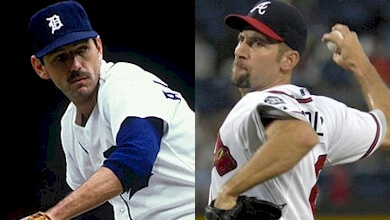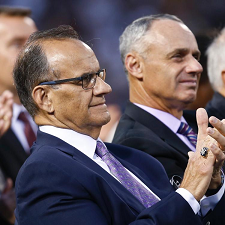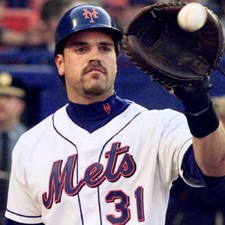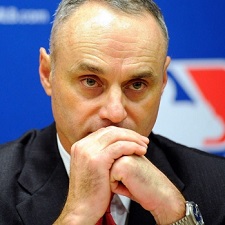AROLDIS, WE HARDLY KNEW YE
Sunday, July 31st, 2016It wasn’t even a deadline trade. It was a trade made 12 days after the deadline. But it was nevertheless a trade made late in the season, around the July 31 deadline (this year Aug. 1), and it qualifies as possibly the most celebrated deadline deal of all time.
On Aug. 12, 1987, the Detroit Tigers acquired a 36-year-old pitcher, Doyle Alexander, who they hoped would help get them to the post-season. On the day the Tigers made the trade, they had a 64-46 record and were a game and a half behind Toronto in the American League East. Post-trade, the Tigers won 34 of 52 games and finished two games ahead of the Blue Jays.
Alexander, the new guy in the rotation, started 11games, won 9 and lost none. The Tigers also won both games in which he did not get a decision, including one a week before the end of the season in which he pitched 10 2/3 innings and allowed two runs, one earned.
That trade, more than any other at this time of year, stands out because of the players who were involved and what they went on to do.
The Tigers got what they wanted, a pitcher who helped them win a division title. The Atlanta Braves, who sent Alexander to Detroit, got what they wanted, too, though they didn’t know at the time what they got.
As often happens in these deadline or shortly after trades, the Braves got a minor leaguer, a Class AA pitcher, whose future was unknown and unpredictable. Fourteen consecutive Braves division championships and 28 years later John Smoltz was in the Hall of Fame.
Minor leaguers acquired in deadline deals seldom see their way to the major leagues, let alone the Hall of Fame. When a team is trading an established major leaguer, it wants to get back the best prospects it can, but the team receiving the established player usually isn’t compelled to go too deeply into its reservoir of prospects.
There is the occasional exception. Last week the Chicago Cubs acquired Aroldis Chapman, the flame-throwing ace closer, from the New York Yankees and were not alone in their desire to add him to their bullpen. The Yankees, who had Chapman on their active roster for only 77 days, could afford to trade a relief pitcher who throws a baseball at 105 miles an hour because Andrew Miller and Dellin Betances also reside in their bullpen. But they weren’t going to give Chapman away for nothing.
 Faced with competition from several other teams and seeing Chapman as the clinching punch on their ticket to the World Series, the Cubs gave the Yankees a four-player package: Adam Warren, major league pitcher, whom the Yankees traded to the Cubs last December for second baseman Starlin Castro, and three minor leaguers, including a 19-year-old shortstop Gleyber Torres, whom they had tried to sign in Venezuela in 2013.
Faced with competition from several other teams and seeing Chapman as the clinching punch on their ticket to the World Series, the Cubs gave the Yankees a four-player package: Adam Warren, major league pitcher, whom the Yankees traded to the Cubs last December for second baseman Starlin Castro, and three minor leaguers, including a 19-year-old shortstop Gleyber Torres, whom they had tried to sign in Venezuela in 2013.
The Yankees have used Warren right away, as a reliever, though they can also use him as a starter, not a common situation in these trades. They’ll have to wait for the others, and they may never see outfielders Billy McKinney and Rashad Crawford, even though McKinney was a first-round selection by Oakland in the 2013 draft. Both McKinney and Crawford were hitting in the .250s in the minors this season, McKinney in Class AA, Crawford in A.
Torres is the one to watch. See where he is in two or three years. This year, at the time of the trade, he was in Class A and hitting .275.
Another minor leaguer to watch, not because he is a prized prospect but to see if he attains major league status, is Hansel Rodriguez, a 19-year-old pitcher from the Dominican Republic, who was the lone player San Diego received from Toronto for outfielder Melvin Upton Jr. In three years he has not risen above rookie leagues. The player price for Upton was low because the Blue Jays are paying the Padres a significant portion of Upton’s salary.
Three days later the frenetically busy Padres continued their quest for prospects in a seven-player trade with the Miami Marlins, who sought an established starting pitcher. They got him in Andrew Cashner, and the Padres got their minor league prospects, first baseman Josh Naylor and starting pitcher Luis Castillo. No guarantee comes with the pair.
Neither one has advanced beyond Class A, meaning the Padres have to hope the players are as good as the scouting reports. Naylor is 19, Castillo 23.
Guarantees? Going back many years, I recall the Yankees’ view of a young shortstop, Rex Hudler, their No. 1 pick in the 1978 draft. Hudler struggled to get beyond Class A, spending his first four seasons at that level and beginning a fifth before starting to move up slowly. Hudler wound up playing for six major league teams over 13 seasons. A personable and witty announcer, he is better known for his broadcasting than his playing.
Not everyone, however, can be a broadcaster, even in this age when all broadcasters seem to be former players. There just aren’t enough so players rise and fall on their playing ability. More players than not never make it out of the minors, and they are among those who are traded in July or August for a major player who can be a free agent at the end of the season or has a contract that his team no longer wants to pay.
Mark Melancon, who has been a terrific closer for Pittsburgh, can be a free agent at the end of the season, and the Pirates didn’t want to give him the multi-year contract that would have been necessary to keep him so they traded him Saturday to Washington for a pair of young left-handed relief pitchers.
Felipe Rivero has pitched for the Nationals the last two seasons and is an established major leaguer. But Taylor Hearn has not pitched in the majors. The question is will he?
I took an informal survey of deadline trades made in the last half dozen years to see how many minor leaguers have played their way to the majors. Here is some of what I found:
On deadline day in 2010, Texas acquired second baseman Cristian Guzman from Washington for two players. Pitcher Ryan Tatusko has never pitched in the majors, but Tanner Roark has pitched for the Nationals for four seasons and has compiled a 36-24 career record with a 3.08 earned run average. This season he has a 10-6 record with a 2.96 e.r.a.
 Three weeks earlier the Rangers obtained pitchers Cliff Lee and Mark Lowe from the Seattle Mariners, who gave Texas four players.
Three weeks earlier the Rangers obtained pitchers Cliff Lee and Mark Lowe from the Seattle Mariners, who gave Texas four players.
Justin Smoak was a major league rookie when the trade was made and today is Toronto’s first baseman, Josh Lueke pitched for two teams in parts of four major league seasons, pitcher Blake Beavan became a career minor leaguer and second baseman Matt Lawson didn’t reach the majors either.
On the same day San Diego acquired Miguel Tejada from Baltimore for pitcher Wynn Pelzer and Los Angeles obtained Scott Podsednik from Kansas City for catcher Lucas May and pitcher Elisaul Pimentel. Pelzer, May and Pimentel never played in the majors.
In the next two days, the last two days of the non-waiver trading period, Detroit acquired pitchers Doug Fister and David Pauley from Seattle for outfielder Casper Wells, infielder Francisco Martinez and pitcher Charlie Furbush, and Atlanta obtained outfielder Michael Bourn from Houston for outfielder Jordan Schafer and pitchers Juan Abreu, Paul Clemens and Brett Oberholtzer.
From the Fister deal, Wells and Martinez have not played in the majors. Furbush has pitched for Seattle since the trade but has been plagued by a shoulder ailment this season.
From the Bourn transaction, Schafer played in the outfield for Atlanta, Minnesota and Houston but is being converted into a pitcher. Abreu pitched in seven games for Houston in 2011, facing 34 batters and emerging with a 6.75 e.r.a. Clemens has pitched the past four seasons for Houston, Miami and San Diego. Oberholtzer has pitched, not well, for the Astros and Phillies.
There has been another side to the deadline deals. Here are some examples of players who have emerged as bona fide major leaguers:
- Shortstop Elvis Andrus and pitchers Neftali Feliz and Matt Harrison were all in the 2007 trade that sent Mark Teixeira from the Rangers to the Braves.
- Catcher Drew Butera was in the 2007 trade that sent Luis Castillo from the Twins to the Mets.
- Outfielder David Murphy was in the 2007 trade that sent Eric Gagne from the Rangers to the Red Sox.
- Infielder/outfielder Matt LaPorta was in the 2008 trade that sent CC Sabathia from the Indians to the Brewers.
- Third baseman Josh Donaldson was in the 2008 trade that sent Rich Harden and Chad Gaudin from the Athletics to the Cubs.
- Catcher Carlos Santana was in the 2008 trade that sent Casey Blake from the Indians to the Dodgers.
- Pitcher Carlos Carrasco was in the 2009 trade that sent Cliff Lee from the Indians to the Phillies.
- Infielder Josh Harrison was in the 2009 trade that sent John Grabow and Tom Gorzelanny from the Pirates to the Cubs.
- Pitcher Patrick Corbin was in the 2010 trade that sent Dan Haren from the Diamondbacks to the Angels.
- Shortstop Jonathan Villar was in the 2010 trade that sent Roy Oswalt from the Astros to the Phillies.
- Pitcher Corey Kluber was in the 2010 three-team trade involving Ryan Ludwick and Jake Westbrook.
- Pitcher Zack Wheeler was in the 2011 trade that sent Carlos Beltran from the Mets to the Giants.
- Pitcher Jarred Cosart was in the 2011 trade that sent Hunter Pence from the Astros to the Phillies.
- Pitcher Kyle Hendricks was in the 2012 trade that sent Ryan Dempster from the Cubs to the Rangers.
- Catcher Tommy Joseph was in the 2012 trade that sent Hunter Pence from the Phillies to the Giants.
- Pitcher Eduardo Rodriguez was in the 2014 trade that sent Andrew Miller from the Red Sox to the Orioles.
- Shortstop Addison Russell was in the 2014 trade that sent Jason Hammel and Jeff Samardzija from the Cubs to the Athletics.
- Pitcher Michael Fulmer was in the 2015 trade that sent Yoenis Cespedes from the Tigers to the Mets.
- Pitcher Jerad Eickhoff was in the 2015 trade that sent Cole Hamels from the Phillies to the Rangers.
- Outfielder Adam Duvall was in the 2015 trade that sent Mike Leake from the Reds to the Giants.

 “Most of the time when I argued with umpires it was to protect my players, to keep them in the game,” said Piniella, who was as fiery as any manager in arguing with umpires. “I respect umpires. They do a good job. But like players and managers they make mistakes sometimes.”
“Most of the time when I argued with umpires it was to protect my players, to keep them in the game,” said Piniella, who was as fiery as any manager in arguing with umpires. “I respect umpires. They do a good job. But like players and managers they make mistakes sometimes.”
 Not surprisingly, a Mike Piazza fanatic criticized me for asking Piazza about his suspected use of steroids in a conference call 10 days before his induction into the Hall of Fame. Using the subject line “The Ravings of a bitter self-indulgent blogger,” the reader wrote:
Not surprisingly, a Mike Piazza fanatic criticized me for asking Piazza about his suspected use of steroids in a conference call 10 days before his induction into the Hall of Fame. Using the subject line “The Ravings of a bitter self-indulgent blogger,” the reader wrote:
 It is up to Manfred to cleanse owners of this mentality. If he is unable to perform that form of lobotomy, let him institute a new rule to replace the so-called Selig Rule, which requires teams hiring personnel for decision-making positions to interview minorities. But only one minority.
It is up to Manfred to cleanse owners of this mentality. If he is unable to perform that form of lobotomy, let him institute a new rule to replace the so-called Selig Rule, which requires teams hiring personnel for decision-making positions to interview minorities. But only one minority.